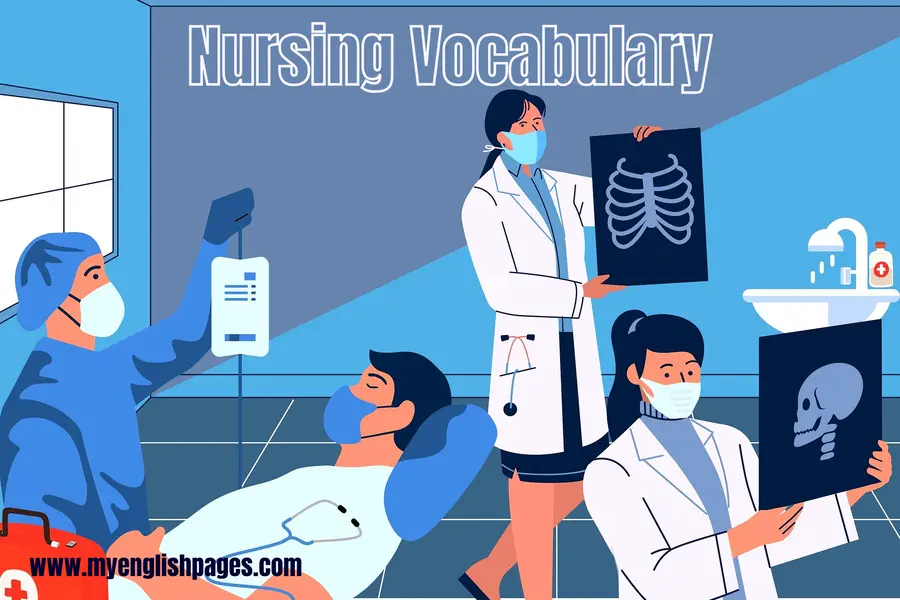Table of Contents
Whether you are an ESL learner preparing for a medical career or simply want to understand healthcare conversations better, learning nurse vocabulary in English is a great place to start. Nurses communicate with doctors, patients, and families every day, so they rely on precise and practical language.
This guide covers the most important medical terms, tools, job roles, and useful phrases nurses often use.
Why Nurse Vocabulary Matters
Nurses use English in many situations:
- Communicating with patients politely and clearly
- Completing medical charts and reports
- Understanding doctors’ instructions
- Using medical equipment safely
- Working with international healthcare teams
Mastering the right vocabulary helps you speak more confidently and professionally in a clinical environment.
Nurse Vocabulary in English
1. Common Nurse Job Titles
Here are the most common terms used to describe different nursing roles:
- Registered Nurse (RN) – a fully trained and licensed nurse
- Nurse Practitioner (NP) – an advanced nurse who can diagnose and prescribe treatments
- Charge Nurse – a nurse who supervises a shift or department
- Nursing Assistant (NA) – helps nurses with basic patient care
- Midwife – a nurse specializing in pregnancy and childbirth
- Pediatric Nurse – a nurse who cares for children
- ICU Nurse – works in the Intensive Care Unit
- ER Nurse – works in the Emergency Room
2. Essential Nurse Vocabulary: Tools & Equipment
These are common items nurses use every day:
- Stethoscope – used to listen to the heart and lungs
- Thermometer – measures body temperature
- Blood pressure cuff / sphygmomanometer – measures blood pressure
- Syringe – used for injections
- IV (intravenous line) – used to give fluids or medication
- Bandage – covers and protects wounds
- Gloves – protect hands and prevent infection
- Scalpel – a small surgical knife
- Gauze – soft cloth used to clean wounds
- Monitor – displays heart rate, blood pressure, and oxygen levels
3. More Tools Nurses Commonly Use
A. Basic Nursing Tools
- Pulse oximeter – measures oxygen levels in the blood
- Tongue depressor – used during throat examinations
- Penlight – small flashlight to check pupils
- Reflex hammer – used to check reflexes
B. Wound Care & Hygiene
- Antiseptic wipes – used to clean the skin
- Cotton balls / cotton swabs – used for cleaning and applying medication
- Medical tape – used to secure bandages or IV lines
- Face mask – protects against airborne infections
C. Hospital Equipment Nurses Use
- Wheelchair – used to transport patients
- Hospital bed – adjustable bed used in patient care
- Blood glucose meter (glucometer) – used to measure blood sugar
- Oxygen tank / oxygen mask – provides oxygen to patients
D. Medication & Treatment Tools
- Pill organizer – container used to sort medications
- Infusion pump – controls the amount of fluid or medication delivered through an IV
- Nebulizer – converts liquid medicine into a mist for inhalation
E. Administrative Tools
- Chart / patient file – records patient information
- Clipboard – helps nurses write or carry documents
- Computer on wheels (COW) – used for digital charting in hospitals
3. Key Medical Terms Nurses Should Know
Here are important words used in hospitals and medical settings:
- Diagnosis – identifying a disease or condition
- Symptoms – signs of an illness (e.g., fever, pain)
- Treatment – the care given to help a patient recover
- Medication – medicine prescribed by a doctor
- Side effects – unexpected reactions to medication
- Contamination – the presence of harmful substances
- Allergy – a negative reaction to food, medicine, etc.
- Vital signs – important health indicators such as heart rate, temperature, and blood pressure
- Recovery – the process of getting better
- Admission – when a patient is officially taken into the hospital
4. Useful Verbs for Nurses
These verbs are essential for daily tasks:
- Administer (medicine, injections)
- Monitor (vital signs)
- Examine (a patient)
- Treat (a condition)
- Assist (doctors or patients)
- Record (information on charts)
- Prescribe (doctors prescribe medicines; nurses explain them)
- Check (temperature, blood pressure, symptoms)
- Discharge (allow a patient to leave the hospital)
5. Common Phrases Nurses Use with Patients

These polite and professional expressions help nurses communicate effectively:
A. Asking Questions
- “How are you feeling today?”
- “Do you have any pain?”
- “Are you allergic to any medication?”
- “Can you describe your symptoms?”
B. Giving Instructions
- “Please roll up your sleeve.”
- “Take a deep breath.”
- “Hold still, please.”
- “You need to take this medicine twice a day.”
C. Offering Help
- “Let me assist you.”
- “Do you need anything?”
- “I’ll be right back.”
Nurse Vocabulary in Action: Sample Dialogue
This simple exchange shows how everyday vocabulary is used naturally in a medical setting.
Nurse: Good morning. How are you feeling today?
Patient: I still have some pain in my chest.
Nurse: I see. I’m going to check your blood pressure and monitor your vital signs.
Patient: Okay, thank you.
Nurse: Please take a deep breath… and relax.
Practice Exercise
Match each word with its meaning:
| 1. Gauze | a. A device to observe vital signs |
| 2. Diagnosis | b. Thin cloth used for cleaning wounds |
| 3. Monitor | c. Signs of an illness |
| 4. Syringe | d. The identification of a disease |
| 5. Symptoms | e. A tool used to give injections |
FAQs About Nurse Vocabulary in English
What are terminologies in nursing?
Nursing terminologies are special medical words and phrases used by nurses to describe patient care. They include vocabulary for symptoms, treatments, body systems, vital signs, equipment, and procedures. These terms help nurses communicate clearly and professionally in hospitals and clinics.
What are the 20 medical terms?
Here are 20 useful medical terms for beginners:
1. Diagnosis – identifying an illness
2. Symptom – a sign of illness
3. Treatment – care given to a patient
4. Medication – medicine
5. Prescription – written order for medication
6. Injection – medicine given with a needle
7. IV – intravenous line
8. Vital signs – key health indicators
9. Blood pressure – force of blood in the arteries
10. Pulse – heartbeats per minute
11. Fever – high body temperature
12. Fracture – a broken bone
13. Allergy – negative reaction to something
14. Inflammation – swelling or redness
15. Infection – illness caused by bacteria/virus
16. Discharge – send a patient home
17. Admission – when a patient enters the hospital
18. Recovery – getting better
19. Side effect – unwanted reaction to medicine
20. Contamination – harmful substances present
What are 10 things nurses do?
Nurses perform many daily tasks. Here are ten common ones:
1. Check vital signs
2. Monitor patients’ conditions
3. Give medication
4. Assist doctors during procedures
5. Clean and dress wounds
6. Record information in charts
7. Communicate with patients and families
8. Prepare medical equipment
9. Educate patients about their care
10. Respond to emergencies
What are the 7 domains of nursing?
NANDA International divides nursing practice into seven major domains. These help nurses organize patient care and understand different human needs.
1. Physiological – relates to the body’s physical functions (breathing, eating, circulation, movement).
2. Psychological / Behavioral – relates to emotions, behavior, and mental health.
3. Safety / Protection – focuses on preventing injury, infection, or harm.
4. Family – involves the patient’s family relationships and support system.
5. Health System – relates to access to healthcare, managing care, and treatment plans.
6. Community – concerns the patient’s environment, resources, and social support.
7. Role / Function – how a person performs their normal daily roles (work, school, self-care).
Note: Some sources merge or rename domains (e.g., “Role/Function” or “Behavioral”), which is why lists vary.
What are the 4 pillars of nursing?
The four pillars of nursing describe the main areas of professional practice that every nurse should follow. They help guide safe, ethical, and high-quality patient care.
1. Clinical Practice – providing direct care to patients, including assessments, treatments, medication, and monitoring.
2. Education – teaching patients, families, and other healthcare workers; continuing to learn and develop professional skills.
3. Research – using evidence-based practice, collecting information, and applying the latest medical knowledge to improve care.
4. Leadership – guiding teams, making decisions, managing care plans, and ensuring safe standards in the healthcare environment.
These pillars support competent and professional nursing across all healthcare settings.
Conclusion
Learning nurse vocabulary in English helps ESL learners communicate with confidence, understand medical situations, and interact professionally in healthcare environments.
Whether you plan to become a nurse or want to improve your medical English, mastering these essential words and phrases is a great first step.


